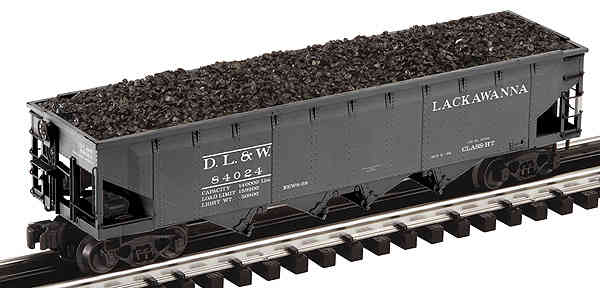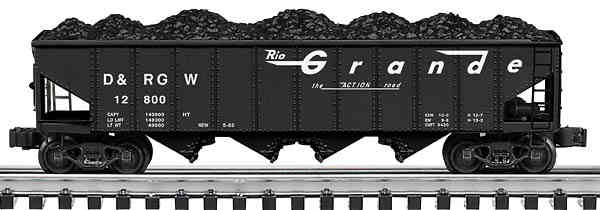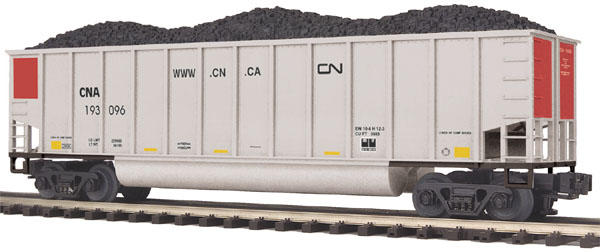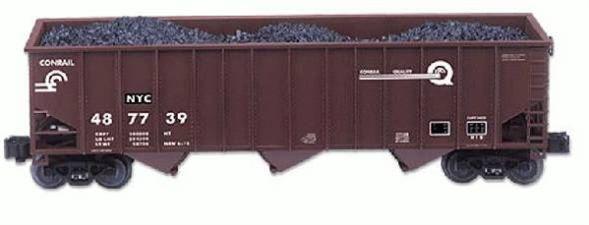Open hoppers are used to haul bulk commodities that do not need protection form the weather. Coal is the most common product carried by open hoppers and all of the O scale 50 and 55 ton hopper models are based on coal hauling prototypes. We have a variety of O scale 70 and 100 ton open hoppers and while most are intended for hauling coal some are based on cars designed to haul iron ore, rock or coke. O scale 70 and 100 ton hopper models are based on prototypes seen on North American railroads from the WW I era to today and can find a home on almost every layout.
70 Ton Open Hoppers
While 50 and 55 ton hoppers were common for most of the 20th century many railroads had a need for higher capacity cars. A car with a 70 ton nominal net weight capacity was the largest car that was practical with plain bearing two axle trucks. The limitations of plain bearings made 70 ton open hoppers the standard capacity for big hoppers built between the WW I era and the end of the 1950s.
Ore Hoppers
Ore hoppers are small in size but carry great weight due to the high density of iron ore. Great lakes ore hauling railroads pull solid strings of ore hoppers from mines to lake docks where the ore is loaded onto ships for delivery to steel mills in the east. While all-rail ore shipments to steel mills are not the norm they did happen. Occasionally ore hoppers will find their way to unusual locations and I even have a photo of a lone GN ore hopper being used to deliver coal in Seattle.
Lionel offers ore hoppers in their traditional product line. The small size of the prototypes makes the scale cars fit in well with O-27 as well as O scale trains.

![]()
![]()
MTH introduced their ore hopper in the 1999 Volume 1 catalog. They have appeared in both the Premier and Railking product lines.

K-Line produced their K671 ore hopper in several road names.

Offset Side Hoppers
Thousands of 70 ton offset side hoppers were ordered by many railroads from the 1930s to the 1950s.
The pre-war Lionel 716 scale diecast hopper was based on a 70 ton 4 bay offset side prototype. Today we have three recent examples of diecast O scale models inspired by the same prototype and the original 716 hopper. Like the pre-war Lionel model they all have spring loaded operating bottom hatches.
The Lionel die-cast scale hoppers were produced in several road names in the 90s. They were last cataloged as a six car B&O set in 2001.

The k-Line 4 bay offset side die-cast hopper was cataloged as the K623. They have continued to be offered as K-Line by Lionel.

MTH introduced their Railking Scale offset side 4 bay die-cast 70 ton hopper in the 1999 Volume 3 catalog in 6 car sets. It was later offered as a separate sale item. A plastic bodied version of this car without operating doors is also available in the Railking line.

Weaver's 70 ton offset side hopper models a 3 bay design.

70 Ton Rib Side Hoppers
Atlas introduced their model of the PRR H21a 4 bay hopper in 2004. The first H21 was built in 1909 as a 50 ton car for hauling coke. Buy 1925 the earliest cars has been rebuilt for coal service to the H21a standard with a 70 ton capacity. The Pennsylvania rostered over 39,000 of these pioneering 70 ton capacity hoppers and they continued in service into the PC era.

The Atlas Trainman 3 bay 10 rib hopper was introduced in 2006. It is based on a standard AAR design and is available with flat or peaked ends.

MTH 3 bay 70 ton hopper also models the common 10 Rib AAR design. It was introduced in the 2007 Volume 2 catalog and features metal detail parts and Kadee mounting pads.

The Weaver 3 Bay 70 ton hopper has 15 Ribs.

The K-Line 4 bay K626 die-cast 4 bay hopper has side 11 Ribs and operating doors.

100 Ton Open Hoppers
When 100 ton freight cars with roller bearing trucks became common in the 1960s hopper cars grew to handle the new larger loads. While gondolas are now favored by many large volume coal users with rotary car dumpers these 100 ton hoppers can still be seen on railroads today.
100 Ton Rapid Discharge Hopper
The MTH Rapid Discharge hopper was introduced in the 1999 Volume 2 catalog. It is based on a prototype designed for hauling rock.

100 Ton 3 Bay Hoppers
The Lionel three bay 100 ton hopper features a die-cast body, operating hatches and rotating roller bearing caps.

The MTH Coke Hopper first appeared in the 2005 Vol 2 catalog. The high sides allow full loading by weight with low density coke.

4 Bay 100 Ton Hoppers
The MTH 100 ton 4 bay hopper is based on a Bethlehem Steel built prototype and features 13 side ribs. It debuted in the 1998 Volume 1 catalog and has been updated with metal detail parts, new style trucks and Kadee mounting pads.

The Weaver 100 ton 4 bay hopper also has 13 ribs but features slightly higher sides.

If anyone has any additions or corrections to offer please let me know. And if you would like to comment on the details of individual models I would like to hear your opinions. Now let's see your photos of your 70 and 100 ton open hopper models. ![]()
Information on other types of O scale freight cars can be found at the link below.
https://ogrforum.ogaugerr.com/t...le-freight-car-guide












